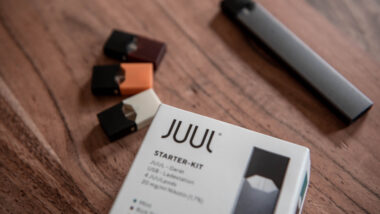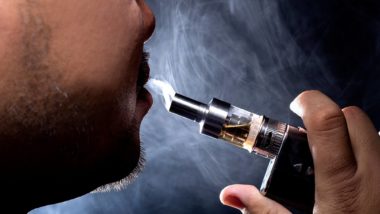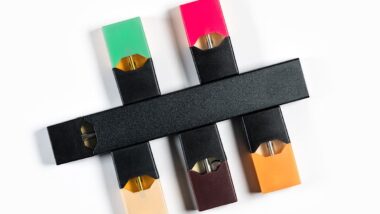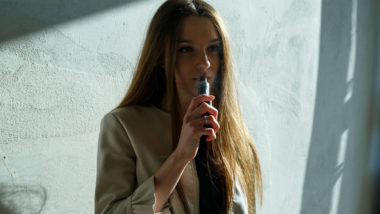Top Class Actions’s website and social media posts use affiliate links. If you make a purchase using such links, we may receive a commission, but it will not result in any additional charges to you. Please review our Affiliate Link Disclosure for more information.
Two federal agencies have released new data that shows there has been a more than 25% decrease in e-cigarette use among U.S. high school students in 2020. Even so, many people have experienced Juul or e-cigarette side effects.
The U.S. Food and Drug Administration and Centers for Disease Control and Prevention released the results of the 2020 National Youth Tobacco Survey on September 9 and it seems that efforts to curb teenage vaping might be paying off. According to the survey, 1.8 million fewer middle and high school students said they were using e-cigarettes than in 2019.
The 2020 National Youth Tobacco Survey is a cross-sectional, self-administered survey of American middle school (grades 6–8) and high school (grades 9–12) students. It was conducted between January and March.
“After two years of disturbing increases in youth e-cigarette use, we are encouraged by the overall significant decline reported in 2020. This is good news,” the FDA’s statement about the survey said. “However, the FDA remains very concerned about the 3.6 million U.S. youth who currently use e-cigarettes and we acknowledge there is work that still needs to be done to curb youth use.”
Ongoing Federal Attention
Federal health officials and governmental agencies have been raising concerns about the potential dangers of vaping, and the flood of teenagers taking up the habit – so much so the U.S. Food and Drug Administration has called it an epidemic.
Vaping among adolescents has increased so much in recent years, U.S. Surgeon General Jerome Adams also declared youth vaping an official epidemic in late 2018. Adams cited the skyrocketing sales of JUUL vape pod e-cigarettes specifically – which saw a 600-percent surge in 2016-2017 – in his declaration.
The National Youth Tobacco Survey says multiple factors have contributed to the increase in teen vaping, most notably the introduction of kid-friendly flavored vape pods and other product innovations.
Disposable E-Cigarette Use Increased
One alarming trend captured in the National Youth Tobacco Survey was a marked increase in the use of disposable e-cigarettes. Among the high school students surveyed this year who vape, 26% said they use disposable e-cigarettes. In 2019, only 2% said they did. More than 15% of middle school vape users said they use disposable e-cigarettes in 2020 while 3% said the same in 2019.
A full 8 out of 10 middle and high school e-cigarette users reported they favor flavored products – with fruit, mint, candy, and menthol being the most common. Fruit flavored vape pods were the flavor of choice among 73% of the young survey respondents.
Meanwhile, the FDA also announced it recently issued three warning letters to companies that sell disposable vape products. Among the targeted companies was XL Vape LLC, doing business as Stig Inc., “a popular disposable e-cigarette brand among youth.” The FDA instructed Stig to stop selling its disposable e-cigarettes because the company doesn’t have the required authorization.
Warning letters were also sent out to Flavour Warehouse LTD, doing business as Vampire Vape and Pretty Women UK LTD for illegally marketing unauthorized menthol-flavored vape liquid.
“We will remain vigilant in monitoring the marketplace, expanding our public education efforts and using our regulatory authority – changing course as necessary – to further ensure all tobacco products, and e-cigarettes in particular, are not marketed to, sold to, or used by kids,” the FDA statement said. “If we see a product that is targeted to kids, we will not hesitate to target that product.”
Other Studies Revealed Dangers of E-Cigarette Addiction

According to the Harvard team’s research, the specific mechanism employed by the vape pods e-cigarettes “ensures the delivery of high doses of nicotine in a low pH form, which is less harsh compared to the higher pH nicotine found in most other e-cigarette brands, thus encouraging deeper inhalation.”
Vape Marketing and E-Cigarette Use Prompt Lawsuits, Class Actions
Several consumers, organizations and even governmental bodies have taken aim at e-cigarette use and the vaping industry by filing class action lawsuits and individual lawsuits and issuing bans on the products.
Washington and Arizona filed lawsuits against JUUL this year over its marketing strategy, saying the company unlawfully targets underage users to sell more e-cigarettes. State officials accused JUUL of violating state laws by courting teenage users with deliberate e-cigarette advertising, mostly through social media, and misleading packaging.
An Arizona high school filed a similar lawsuit against JUUL in federal court in California, drawing parallels between the company’s strategy and that of Big Tobacco. “(The) incredible progress towards eliminating youth tobacco and nicotine use has now largely been reversed due to e-cigarettes and vaping,” it said.
JUUL has denied targeting teenagers and said it stopped advertising its flavored vape pods in response to public concerns they are especially popular with kids. In January, JUUL told the Associated Press it was focused on “working cooperatively with attorneys general, regulators, public health officials, and other stakeholders to combat underage use and convert adult smokers from combustible cigarettes.”
Class action lawsuits have also been proposed by plaintiffs who claim the e-cigarettes and vape pods caused health problems.
California recently enacted a law prohibiting the sale of most flavored tobacco products– including e-cigarette vaping cartridges – at retail stores starting Jan. 1, 2021.
And the U.S. Food and Drug Administration enacted a partial flavored vape ban earlier this year, aimed at e-cigarettes that use pre-filled one-time-use pods. The ban prevents the sales of vape pods featuring sweet, fruity and mint flavors – not menthol or tobacco flavored ones – most often found at convenience stores and vape shops.
Administration officials have said the ban is aimed at reducing the prevalence of teenage vaping.
Join a Free JUUL E-Cigarette Class Action Lawsuit Investigation
If you or your child suffered seizures after vaping with a JUUL e-cigarette, you may benefit from participating in a free JUUL class action lawsuit investigation.
This article is not legal advice. It is presented
for informational purposes only.
ATTORNEY ADVERTISING
Top Class Actions is a Proud Member of the American Bar Association
LEGAL INFORMATION IS NOT LEGAL ADVICE
Top Class Actions Legal Statement
©2008 – 2024 Top Class Actions® LLC
Various Trademarks held by their respective owners
This website is not intended for viewing or usage by European Union citizens.
Get Help – It’s Free
Join a Free JUUL E-Cigarette Seizure Class Action Lawsuit Investigation
If you qualify, an attorney will contact you to discuss the details of your potential case at no charge to you.
PLEASE NOTE: If you want to participate in this investigation, it is imperative that you reply to the law firm if they call or email you. Failing to do so may result in you not getting signed up as a client or getting you dropped as a client.
E-mail any problems with this form to:
Questions@TopClassActions.com.













